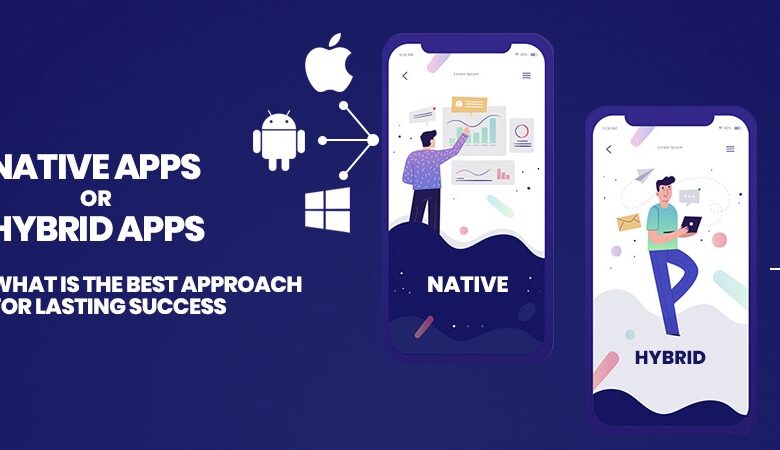Development and Business- Hybrid or Native applications?

The mobile app market is booming. That’s not anybody’s surprise. With over 2.7 billion mobile users around the world, it’s a natural development to have a booming application industry. This is because there is still a growing penetration of gadgets such as tabs and mobiles. This is one train that will not slow down fast.
A significant question faced by all developers and companies is whether their app should be a native or hybrid application in this increasingly growing industry. There are different variables that drive this response, and below we will illustrate the all-important distinction between these two and what to keep in mind when figuring out the next phase in your mobile application development.
How it all began!
The broad classification that exists in the application world, the important one being web software, the apps that began it all, needs to be recognized before delving deep into the mobile application world.
Web applications are applications which use web browsers to operate over an internet connection. Using cross-platform standard web technologies like HTML, JavaScript or CSS, these applications can be readily written by a developer.
Without being reworked for each individual platform, these apps have the distinct benefit of running across platforms, making their development costs much smaller than what you would have when designing mobile applications.
So, if a web application can run across platforms, why does a mobile application still need to be developed? The response to this will be the problems that mostly occur due to the UI design. A mobile phone is a highly customizable system and features such as push alerts and offline mode have become important in the day-to-day activity of users. The inaccessibility of these applications via the App Store also presents a challenge for audience participation and limits the app’s potential scope.
Applications for Mobile
It was the year 2007 when the first iPhone was released, and it’s really hard to imagine a life without a smartphone and the other things that go with it, including games, synonyms. Apart from providing the basic features, each smartphone often acts as a personal assistant loaded to the brim with applications that satisfy one or more of our needs or wants in some way or form.
There needs to be a mobile application that is stable and sensitive at all times. This is the user’s basic expectation, the buyer of your item.
Native and Hybrid Mobile Apps are divided into two additional categories. This is where a decision needs to be made concerning the creation of your application. You need to think about certain aspects for both types of applications before beginning to construct an application, as both have certain pros and cons attached to them.
Applications Native
Native applications are called an application that is explicitly written on the platform on which they are being created. That implies that the app is developed, built and coded separately for each of your operating systems, i.e. iOS, Android and Windows.
These applications are complex since the language of the software, programming tools, user interface components, and software development kits for each OS are taken into account separately. But these technologies are more trusted than hybrid apps in terms of scalability and sustainability.
Via an App Store that has its own downsides attached, these apps are published and distributed.
Applications Hybrid
Hybrid applications are named applications that are a mix of web and native apps. This software has been designed to operate across multiple operating systems as a single app. They can be defined as websites packed in a native box, in other words. The app looks and sounds like a native app, but several web pages ultimately power it.
In contrast, they are easier to manufacture and can be programmed and implemented in a shorter time frame.
Study in detail
Now that you know what these applications are, we can see just what, in terms of features and beyond, sets one above the other.
On the other hand, web technologies used in hybrid applications are HTML, CSS & JavaScript, and native applications use various technologies and languages depending on the operating system.
In addition to native apps running on the OS computers, hybrid apps run in a web view.
A hybrid app requires native plugins to access platform functions such as camera, etc., while native apps enjoy free access to them.
Hybrid apps need to be designed only once, whereas native apps need to be separately coded for each OS.
Each App’s benefits & limitations
As illustrated above, there are certain advantages and disadvantages associated with each kind of app. Now let’s dive into the same thing in detail.
Advantages of Native App
Output
The application achieves smoother performance on every platform due to the difference in coding between devices and the language unique to each OS.
Velocity
In terms of speed and performance tests, a better output will be produced as each application is individually configured for the OS. The use of memory and battery is also taken into account in individual growth, which also leads to greater speeds.
Experience with Users
Mobile apps are a product that runs from the client on a continuous feedback loop. In terms of scrolling, gesture recognition, and effects & animation, native apps have an interface that is much easier, making it much more enticing to consumers.
Security Security
The maximum efficiency of the hardware is employed in native apps, which is the only way to protect data.
Versatility
Native applications, such as camera, GPS, microphone, etc., have quicker access to inbuilt system utilities, making it easier to exploit all that the hardware has to give in the application.
Customization
Native software creation means that the app is structured to accommodate any layout and screen size, because of the number of options available to us in terms of smartphones on the market.
Disadvantages of a Native App
The Time
Instead of just coding once, it takes a lot longer to design, run and build for different platforms.
Upload and upload.
Costs
There is a different language for every OS to be coded and created in. Multiple development teams are needed for different platforms in the process of creating a native app, thereby raising the cost of developing the app.
Hybrid App Advantages
Decreased construction costs
A hybrid application is best if you have budgetary constraints, since it needs to be programmed only once for all platforms.
Maintenance service
As the applications are built into a native shell, it makes it much simpler to upgrade the content. So they’re a venture of low downtime.
Shorter Time for growth
A hybrid app has a much shorter duration of incubation, making the incubation period much shorter. This makes it easy to introduce an app with tighter deadlines in the industry.
Hybrid Applications’ drawbacks
Performance
This is where they struggle with hybrid apps. As it differs from application to application, the extra layer of code between the source code and the target mobile application will result in performance loss.
Debugging with
The extra layer of code also makes it a boring affair to debug. Without adding any new bugs in the software, developers have to ensure that the code remains in line with the targeted operating system.
Experience with Users
The user interface is extremely erratic for hybrid apps compared to native apps. The other is adversely affected by concentrating on one unique OS.
Hybrid App Advantages
When it comes to the highly competitive world of mobile app growth, the first impression is the final impression as the customer determines the fate of the app in the long term. One needs to maintain a smooth user interface to ensure that they download the app and it remains on the device. While the initial investment in a native app’s growth appears to be much more than that of a hybrid app, it pays off in the long run. The money you spend on fixing the bugs that occur with the sub-par experience provided by a hybrid app would carry the count up to comparable amounts.
In the time to get to the market, you might save money and depending on the complexity of the app to maintain once source code could seem like a very desirable choice.
Additionally, the days of a seamless hybrid app are far away, even with the increasing 4G penetration. When it comes to the added functions unique to the OS on which it is installed, native apps have an upper hand and best in class protection for your info.
In the above passages, all the context required to decide between the two has been outlined and cross-platform integration is important, but what’s the point if your customers don’t like it?
It was all about how quickly one could market their app in the initial years of app growth, but at that time, the user interface was not a clear distinction in the app wars, while customer experience now reigns supreme. That’s the line at the right.
Author Bio:
Steve Joel is the writer of MavenDigital. He’s the maker of more than 20 featured games. Jim, a blogger at MavenDigital, also talks about software design and growth and the future of technology at outlets ranging from Bloomberg TV to Google.He is currently employed in a mobile app development company in dubai.





